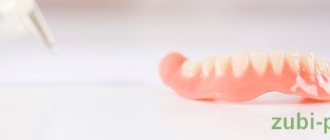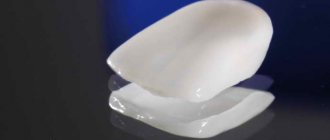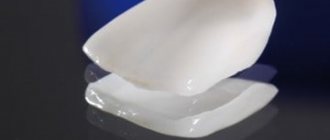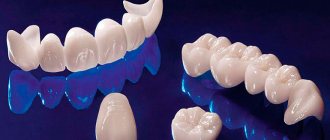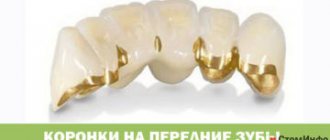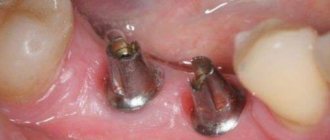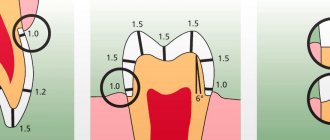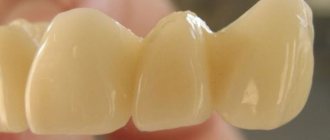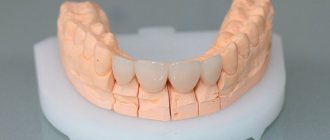Warranties for dentures
If complications arise, the patient must immediately notify the doctor or clinic registrar and immediately attend an appointment with a specialist2.3. When establishing warranty periods for dental services (work), you must be guided by tables No. 1, No. 2 of this provision. In this situation, the guarantee is established by default without a separate indication in the medical record. 2.4. In cases where a guarantee is not established for the service provided (work performed), it is established in a shortened period, or when a warranty obligation arises that is not provided for in this provision, the attending physician is obliged to reflect the situation mentioned in this paragraph in the medical record with a clear wording: “Without guarantee.” or “Months Warranty”. Special conditions under the warranty must be familiarized with signature in the medical record.
3. The warranty does not cover: 3.1.
The service life of artificial teeth depends on a number of factors, which include:
How is the rehabilitation period after installation of a prosthesis?
During the period of soft tissue recovery after prosthetics and the patient’s adaptation to the structure, some problems may arise. For example, a denture may interfere with the usual closing of the jaws (due to the long-term absence of a tooth of normal anatomical shape). In some cases, gum inflammation, pain, and redness may occur. In general, this is all normal, since the doctor treated the tooth, the gums were injured, because it was necessary to align the position of the mucous membrane along the contour of the crown. But if the discomfort not only persists, but intensifies, you should tell your doctor about it. And as soon as possible.
You can avoid unpleasant sensations if you follow a gentle regimen in the first days after installing the prosthesis: gently brush your teeth with a soft brush, eat pureed food.
Crown made of zirconium dioxide - 12,500 rub.
The price includes all manipulations for the manufacture, installation and fitting of the crown, as well as taking impressions.
Creation of a Prettau zirconium dioxide crown in 1 day, using 3D CAD/CAM modeling technology. Save RUR 5,500 >> Call now or request a call
Working hours: from 9:00 to 21:00 - seven days a week
Warranty Statement
It is important that the correct cement is used to fix the crown, which is resistant to moisture, and its thickness can be kept to a minimum. This special material dries quickly, 2-3 minutes are enough to set, and retains its strength for a long time. The duration of wearing the prosthesis also depends on this factor.
Info
How to determine that a metal-ceramic structure requires correction or replacement? This is done by a dentist; you must regularly go for preventive examinations. Changes are noticeable already in the first stages of tooth decay. Monitoring the condition of the oral cavity should be carried out once every six months; many clinics do not charge money for examinations.
Advantages and disadvantages of ceramic crowns
Advantages of ceramic crowns
Superb aesthetics.
In modern orthopedic dentistry, ceramic crowns are undoubtedly the most aesthetic. Only a dentist can distinguish high-quality crowns from natural teeth after a very thorough examination of the oral cavity.
Strength.
Many specialists use ceramic crowns only for the front row of teeth. However, pressed ceramics are a highly durable material that is also quite suitable for replacing chewing teeth.
Hypoallergenic.
Ceramics is an absolutely safe material, does not emit harmful substances, is biologically inert, and therefore is not perceived by the body as something foreign.
Durability.
Ceramic crowns do not absorb foreign odors or pigment, so they maintain an impeccable appearance for many years. You just need to follow the rules of hygiene and visit the dentist at least twice a year for a preventive examination.
Disadvantages of ceramic crowns
Apart from the rather high cost compared to prosthetics made from other materials, as well as the presence of some contraindications, ceramic crowns have no other disadvantages.
Installation of ceramic crowns is contraindicated in the following cases:
— Inflammatory diseases of the oral cavity. - Severe osteoporosis. - Pregnancy. — Acute systemic diseases. — Weakening of the immune system after an illness.
How to place a crown on a tooth
Attention
Difficulties arise in accurately fitting the crown to the tooth.
But compared to gold teeth, titanium teeth last longer and are cheaper. The top of the cast frame is covered with ceramic mass; this cladding is applied manually in layers. Each layer is fired in a kiln at high temperatures, which allows for a better chemical bond between metal and ceramics.
In terms of quality, strength and aesthetics, metal ceramics are second only to metal-free ceramics. Titanium gives a grayish tint, so it is not used to restore front teeth. The ideal option for the front incisors is crowns made of gold or platinum.
Service life of a metal-ceramic crown The service life of crowns depends on what kind of material was used. According to experts, products made from nickel and cobalt chromium should be replaced after 8-10 years of use. With proper care, gold and titanium crowns can last up to 25 years.
Content:
The quality of dental prosthetics directly depends on the material from which the crowns are made. Today, ceramic structures (other names: metal-free, porcelain, glass-ceramic) are considered one of the best. Ceramic crowns are highly durable and biocompatible. In addition, they cannot be distinguished from natural teeth.
However, the cost of ceramic crowns is several times higher than the cost of metal-ceramic and metal structures. Should you choose ceramics, despite the high cost, or prefer cheaper designs? What is the cost of ceramic crowns in Krasnodar? Besides the high price, are there any other disadvantages to ceramic crowns? How are they made and installed? Are there any contraindications? We will talk about all this in this article.
What is the legal warranty period for dental prosthetics?
However, there is a caveat: in all medical centers they will be able to replace or adjust your prosthesis free of charge only if the patient complies with all the instructions issued by the attending physician. Warranty and service life of dentures So, the warranty for dentures provided by the medical center ranges on average from one to two years. In extremely rare cases, the warranty on a denture may be three or five years. If the patient regularly visits his doctor during this time, carries out hygienic procedures daily and more than once, the guarantee will be valid and in case of damage to the prosthesis, you can count on its replacement or repair. It will be clear from the prosthesis itself whether it broke on its own or whether external efforts were made, whether maintenance was carried out.
Duration of operation of such crowns
In addition to the aesthetic part of this issue, the price and service life of the crowns are very important. If you use a prosthesis without metal, purely made of ceramics, it can last about 10 years.
The fact is that during its installation, an adhesive material of special strength is used, which will last a couple of years longer than its metal-ceramic counterpart mounted on dental cement.
Prices for this type of product have a wide range (from $300 to $2000 per unit) and depend on many parameters (manufacturer, materials, manufacturing method, etc.). Ceramic crowns can withstand standard chewing loads perfectly. After a chip has formed, these orthodontic prostheses can be easily reconstructed.
Due to the lack of a frame, such manipulations are carried out much faster and easier than with metal-ceramic analogues.
If more or less serious damage occurs, the all-ceramic crown can simply be polished.
Important facts about metal-ceramic crowns
Because making such a prosthesis is a long and painstaking manual work, and the service life of metal-ceramic teeth and the patient’s comfort depend on the master who performs it. The price of the product depends on many factors, but you should mainly focus on the following points:
- Metal or metal alloy from which the frame will be created;
- Type and manufacturer of ceramics;
- Type of cement;
- The work of a doctor, which will include examination, treatment and, accordingly, the creation of a prosthesis.
What does quality depend on? Before going to see a doctor, many people who want to have prosthetics spend a long time searching on the Internet for the necessary information about teeth made of metal-ceramics and their service life, and most importantly, what determines their quality. Circumstances affecting the service life of the prosthesis:
- It is important how perfectly the teeth were treated and prepared.
Metal-ceramic crowns 1 year 5-7 years 5. Metal and stamped crowns 1 year 5-7 years 6. Removable and clasp dentures (full and partial) 1 year 3-5 years 7. Metal inlays, SPS, gold 1.5 year 5 -7 years 8.
Works and structures not included in those listed above 1 year - Note: 1. In case of unsatisfactory oral hygiene, the warranty and service life for all types of prosthetics are reduced by 50%. 2. If the schedules of preventive examinations and hygiene visits provided for in the treatment plan are violated, the guarantee is canceled. 3. When using prosthetics on implants, the warranty and service periods are determined in accordance with the design of the prosthesis. 4. If the recommended treatment plan is not followed, warranty periods and service periods are not established. 5. During the warranty period and service life, relocation of removable dentures is carried out on a reimbursable basis. 5.5.
- If you experience pain and bad breath that is not associated with other diseases, you should contact the clinic.
Perhaps these are signs of incipient caries under the crown. If help is not provided in time, the risk of developing pulpitis and fistula formation increases, which can lead to damage to the tissue and bone of the jaw; - A visit to the dentist is required if chips or cracks appear on the crown. In simple cases, restoration of the product is sufficient, but if the damage is serious, up to the exposure of the metal base, a complete replacement of the prosthesis is required.
If metal-ceramic crowns are installed, you should definitely inform a specialist about this when undergoing an MRI of the brain.
Metal can distort the data of a diagnostic study and interfere with the high-quality operation of the device.
Rules for caring for ceramic crowns
Timely, systematic, and most importantly, proper care can significantly increase the service life of this type of prosthesis, such as ceramic crowns.
The first thing to avoid is excessive impact loading on these structural elements. Eating hot and cold food at the same time can also reduce the lifespan of dentures.
Teeth made from ceramic materials should be cared for no less carefully than their natural counterparts.
Plaque cannot harm the dentures themselves, but the entry of bacteria under the crowns can lead to the development of caries and accelerated destruction of the supporting chewing elements.
Using a good fluoride toothpaste will help take care of another vulnerable spot - the area of the gums next to the crown.
Do not forget that visiting the dentist for preventive purposes 1-2 times a year for all people is a prerequisite for maintaining oral health.
Legal guarantee for crowns
The guarantee of the quality of treatment is a certain minimum time period of the patient’s clinical well-being after treatment, during which no complications appear and the functional integrity of the manufactured fillings, dentures, crowns, and orthodontic devices is maintained. The warranty period is the period during which, in the event detection of a defect in the work performed, the patient has the right, at his own choice, to demand: - free elimination of deficiencies in the work performed (service provided); - a corresponding reduction in the price of the work performed (service provided); - free production of another item from a homogeneous material of the same quality or re-performance of the work .
In modern dentistry, restoration of the dentition is possible with the help of dentures or crowns, and one of the most popular materials for restoration is metal-ceramics. Such designs combine attractive appearance with convenience and durability, and the installation cost is relatively low. Like any other type, metal-ceramic crowns have their own service life, which can vary from 7 to 15 years. This difference is due to the type of materials, care, individual characteristics and level of professionalism of the doctor who installed the crowns. To extend the life of the products, it is necessary to follow a number of care recommendations.
Crown manufacturing technologies
There are several options for manufacturing technologies for metal-free ceramics. Each of them has several features.
Type 1: firing of ceramic mass on a model
The ceramic mass is exposed to high temperatures in a vacuum. Until now, the firing process was carried out on platinum foil. Today, production occurs using a model in which phosphates are added. This increases the material's resistance to high temperatures and reduces material costs for production. Among the advantages of the technology are speed of production, accuracy, and the ability to achieve the desired shade.
Type 2: production by centrifugation
The frame is cast using centrifugation: the ceramic mass, accelerating, enters the mold and is then fired. The advantage of the method is the complete absence of porosity of the material and the possibility of precise polishing. Among the disadvantages are the technical complexity of manufacturing. In addition, bridges cannot be made using this technology.
Type 3: pressing (for Empress E.Max technologies)
Pressing is the process of shaping a material under pressure at high temperature. The crown is made on the basis of a wax structure. The resulting product has high aesthetic qualities, fits precisely to the support, and is resistant to wear. The technology is used for the manufacture of ceramic crowns with or without a frame.
Type 4: ceramic blank milling (CAD/CAM)
It is possible to achieve high precision of a pressed ceramic crown and reduce its production time using CAD/CAM technology. Using a CAD system with an intraoral scanner (or after scanning the resulting impressions), the doctor enters the received data into the computer and receives a future project (electronic impression), and the CAM system prepares the manufacture of the prosthesis by milling based on the received project. All information is sent to milling equipment, where the final design is created from blanks.
What is the service life of metal-ceramic structures?
According to the results of a study by the WHO organization, such crowns retain their quality for 7-9 years on average, and the following factors can have a negative impact on their service life:
- Improper care, negligent attitude towards oral hygiene;
- individual physiological characteristics;
- frequent consumption of solid and unhealthy foods (nuts, seeds, soda, etc.).
In 90% of cases, patients experience atrophy of the gum tissue, which is why crown replacement is required after 6-7 years; in some cases, the loss of adjacent teeth occurs, due to which it is necessary to make another structure to restore the row. Gum recession usually occurs due to age-related changes in the body - this is a natural process, as a result of which food particles, liquid and other small elements can get under the crown, eroding the cementing composition and destroying the product.
Practice knows a number of cases when patients did not change metal-ceramic crowns for 12-15 years; Sometimes this can be explained by careful care and good physical condition of the gum tissue, but more often it is a matter of too late contacting a doctor. Often, teeth under crowns that have not been replaced for more than 10 years are almost completely destroyed due to the development of caries. Since the enamel and dentin are hidden by a ceramic surface, the patient may not be aware of the presence of the disease for a long time.
When replacing, there are often cases when instead of crowns it is necessary to install a tooth implant, which cannot be restored in any other way.
Most clinics provide an official guarantee for metal-ceramic crowns; its validity period is 1-3 years, depending on the specific institution and materials. The warranty requires that the crown be intact and not destroyed under mechanical loads during the specified period, and if it fails prematurely, the structure can be replaced free of charge.
Table. Comparison of service life of different types of dental crowns.
| Crown type | Components | Life time | Price |
| Metal ceramics on implants | Base – metal, ceramic coating | 8-12 years | 15 thousand and above |
| Based on precious metal alloys | Platinum, gold and palladium alloy, ceramic coating | 10-12 years | 25 thousand and more; the cost of a base based on precious metals is assessed individually |
| Zirconium based | Zirconium base with ceramic coating | 10-15 years | From 25-27 thousand rubles |
Classification and types of metal-free crowns
The classification of metal-free prostheses is misleading for many. It is necessary to distinguish between the concepts “ceramic” and “metal-free”. In the first case we are talking about pure ceramics. The second group includes ceramics itself and other materials: plastic, ceramic composite, zirconium dioxide - that is, all those that do not contain a single gram of metals. By the way, zirconium dioxide is also not a metal, but at the same time it is not ceramic, as many people believe. This is a completely separate material, which relates specifically to the group of “metal-free prostheses”.
Types of metal-free crowns
So, metal-free dentures can be made from the following materials:
- zirconium dioxide (pure) – due to its high strength, it is used in prosthetics of chewing teeth. At the same time, it is very transparent, so it is also suitable for front teeth (but transmits less light than ceramics, and therefore is slightly less aesthetic). Zirconium itself is a metal, but its dioxide is no longer
- zirconium dioxide coated with ceramic - in addition to strength, it gives an excellent aesthetic appearance,
- ceramic composite – a combination of ceramic mass and composite material. Compared to composites, it is more durable, and with ceramics it is easier to process, since it does not require baking,
- and, of course, classic ceramics (including pressed ones). She is porcelain.
On a note! Metal-free prostheses also include plastic products. They are more often used for temporary structures. They have high dye absorption and fragility. They are distinguished by ease of manufacture and low cost.
Types of ceramic prostheses
There are two types of ceramic crowns made from pure material. The first - classic solid (porcelain) - are made from a solid ceramic mass by firing or casting. The second type is pressed ceramics. Represented by the IPS E.Max® and Empress® brands.
- IPS E.Max material is a high-strength glass ceramic based on lithium disilicate. The material transmits light well. In terms of optical properties, it is as similar as possible to natural tooth enamel. Crowns made from this material are suitable for both the anterior and posterior groups,
- Empress material – these crowns are also based on glass ceramics, but with the addition of leucite (mineral component). Empress dentures are characterized by very high aesthetic properties, but are not very resistant to increased loads. They are placed only on the front teeth.
Pressed products are considered the most advanced method of dental prosthetics, as they are created using modern computerized and robotic CAD/CAM equipment.
conclusions
Metal-ceramic crowns are a popular type of structure for dental restoration, combining optimal quality with a reasonable price. The service life of the products is 7-9 years; with careful care and health care, it can be increased to 10-15 years. It is advisable to regularly visit the dentist and check the condition of the teeth and crowns so that if problems arise, they can be detected and eliminated in time.
Video - Metal-ceramic dental crowns
Teeth are normal Dental prosthetics Teeth made of metal-ceramics, service life comparison table
The dental clinic will give you a 12-month guarantee on prosthetics. On average, a metal-ceramic crown lasts 8-10 years, provided that it is manufactured and installed with high quality. How the patient cares for his artificial teeth also plays an important role.
Types of ceramic crowns
Ceramic crowns differ in the thickness of the product itself, the color and material from which they are made.
To install dentures, it is necessary to grind down the natural tooth in order to secure it tightly to it.
The thinner this design, the less chewing element will be ground off and, accordingly, the longer such a crown will last.
Some analogs are made from lithium disilicate, that is, glass ceramics, which has a high degree of strength and is ideal for prosthetics, both in the anterior and chewing sections.
Leucite (a mineral of igneous origin) is added to some specimens. This material is more fragile than the one described above, but it is more aesthetically pleasing. It is recommended to install it on the front teeth.
Solid zirconium crowns are also very popular in dental clinics and have excellent reviews from their users. This material is a white metal.
Its color palette is not as wide as that of ceramic products, but the cost is much lower. It is worth noting that these crowns have an absolute advantage - increased strength.
In any case, the visual difference in the appearance of teeth before and after the installation of these orthodontic structures will be colossal. A crown on a zirconium base, coated with a layer of ceramics, is the latest development in prosthetics. The white material, unlike metal, does not shine through the porcelain shell, which allows you to achieve excellent aesthetic results with high strength and wear resistance of the structure.
In addition, the biological compatibility of a ceramic crown on a zirconium frame eliminates the risk of allergies and periodontal inflammation.
There is a mixed type of crown, which consists of a zirconium frame coated with ceramic.
This “skeleton” is created on the basis of a computer model, and then individually cut out on a milling machine, and the color is selected to match the shade of the patient’s teeth.
There are also ceramic crowns (or other materials) that are fixed in the form of implants. First of all, when installing them, it is important to determine the area where these orthodontic elements will be located.
If we are talking about the location of the smile, then preference should be given to crowns made from a metal-free analogue with a ceramic abutment. In the area of chewing teeth, where aesthetic qualities play a secondary role, metal-ceramic crowns may be quite acceptable.
I also often use porcelain crowns in dentistry. They are made from pressed ceramics without the addition of metal impurities.
The production technology uses porcelain produced by press casting with further firing.
Dental crowns made using this technology have a good level of strength, although according to this criterion they are inferior to their metal and metal-ceramic counterparts.
But crowns made of ceramics, which do not have metal parts, are significantly superior to other prostheses in terms of aesthetics and similarity to natural teeth. The adherence of the gums to such porcelain orthodontic structures is not always optimal.
They can also negatively affect the condition of the natural teeth touching them in some patients.
In any case, they have much more positive characteristics and properties, due to which they are in great demand among people who are faced with the choice of which prostheses to install?
The first step in the porcelain ceramic crown manufacturing process consists of taking individual measurements from the individual client's occlusal elements.
To do this, the dentist usually removes a small layer of dental tissue (about 1 mm), which should provide a more durable fixation of the crown. After this, using a special color scale, the desired shade of the future prosthesis is selected, which must fully match the color of the patient’s natural teeth.
After collecting the necessary data, the process of creating a porcelain tooth begins.
The form for the production of this product is usually platinum foil. This choice is due to the similar thermal properties of platinum and porcelain.
Next, the prepared matrix is mounted on a jaw model, filled with ceramic mass and sent for annealing.
Then the material is vacuum heated at high temperature, and the porcelain blank undergoes additional processing, during which the crown is given the required dimensions.
The final appearance of the prosthesis takes place after going through the process of staining and glazing.
What determines the service life of a metal-ceramic crown?
Appearance of metal-ceramic crowns
The service life of crowns depends on the following factors:
- How was the preparation for prosthetics carried out?
.
Most often, patients who have crowns installed are faced with a problem of poor quality. Gradually, an inflammatory process begins at the tip of such a root: the gums swell and pain occurs. As a result, the product has to be removed, the tooth treated, and a new crown made and installed. Often it comes down to removal.
Also, if the preparation for prosthetics was carried out poorly, the product may break off. The technician must adhere to the correct installation technique. For example, if only the root remains of a tooth, then the upper part should be restored not with filling material or a pin, but with the help of a stump inlay.
- Professionalism of a specialist
.
Much depends on the professionalism of the doctor. He must thoroughly grind hard tissues for the crown, and also correctly take impressions. If the dentist violates the technology of grinding hard tissues or takes impressions inaccurately, the crown will not fit tightly enough to the tooth tissues. Because of this inaccuracy, saliva, food debris, and plaque begin to enter the lumen, which leads to the development of inflammatory processes in soft and hard tissues.
- Professionalism of the technician
.
The impressions taken by the doctor go to the laboratory, where the dental technician directly uses them to make crowns. The color and shape of the future crown, and how well it will match the parameters of the patient’s teeth, depend on the technique.
Preparing a tooth for a crown?
Preparing a tooth for a crown usually requires two visits to the dentist. During the first, the tooth is examined and prepared, and during the second, a permanent crown is placed.
First visit: examination and preparation of the tooth
During your first visit to prepare for a crown, your dentist will take several x-rays to examine the roots of the tooth that will receive the crown and the surrounding bone. If a tooth has significant decay, or there is a risk of infection or damage to the tooth's pulp, root canal treatment will have to be performed before a crown can be placed.
Before the crown process begins, your dentist will administer anesthesia to numb the tooth and surrounding gum tissue. Then the tooth on which it is planned to install a crown will be ground from the chewing surface and on the sides to make room for the crown. The volume of dental tissue to be removed depends on the type of crown that is planned to be used (for example, all-metal crowns are thinner and therefore require the removal of less dental tissue than all-porcelain or metal-porcelain crowns). If, on the other hand, a significant amount of tooth structure is missing (due to decay or damage), the dentist may use a filler to “fill in” the tooth, giving it the ability to support a crown.
After adjusting the shape of the tooth, the dentist will take an impression of the tooth, which is necessary to give the correct shape to the dental crown. Impressions of the teeth above or below the tooth receiving the crown will also need to be taken to ensure that the crown will not affect your bite.
The impressions are sent to a laboratory where the crown will be made. It is usually sent to the dentist's office in two to three weeks. If the crown is made of porcelain, the dentist will also select a shade that most closely matches the color of the adjacent teeth. During this first visit to the dentist, he will make a temporary crown to cover and protect the prepared tooth while the permanent one is made. Temporary crowns are usually made of acrylic and held in place with a limited-lasting cement.
Second visit: obtaining a permanent dental crown
During the second visit, the dentist will remove the temporary crown and check how the permanent crown fits on the tooth and how well it matches the color of the adjacent teeth. If both of these issues are resolved positively, the dentist will apply local anesthesia to numb the tooth, and the new crown will be placed in place, secured with a permanent cement.
What can be done to extend the life of crowns?
If you want the crown to serve you for a long time and faithfully, strictly follow all the specialist’s recommendations after installing artificial teeth:
- Be sure to take dental x-rays before your crowns expire under warranty. Even if absolutely nothing bothers you, these conditions must be met, since very often inflammatory processes occur in the root area. Such defects occur if the doctor performed the work poorly.
- If such a defect is discovered before the end of the warranty period for the product, the clinic is obliged to treat the tooth at its own expense and make a new crown. If you make such a complaint after the crown warranty has expired, you will have to re-treat the tooth out of your own wallet.
- Avoid solid and tough foods. You will have to avoid many products that can damage ceramics. Do not bite hard nuts or crackers; this may cause cracks and chips, which may result in the crown breaking off.
- Follow the correct method - move the brush from top to bottom, sweeping plaque and food debris towards the edge of the tooth.
- It is advisable to rinse your mouth after every meal.
- If you wear a metal-ceramic bridge, pay special attention to cleaning the irrigation channel, which is located on the gum side.
- Do not remove your denture at night without your doctor's permission. This can negatively affect the condition of the oral cavity and bite.
- Remember that nicotine will stain your new teeth over time, so it's best to stop smoking.
Installation of ceramic crowns
It has already been proven that the latest generation of crowns made by casting are not as fragile as they were several years ago.
Therefore, now you can safely place metal-free ceramics on your chewing teeth.
Here everything depends only on the client’s desire. And yet, metal ceramics are not losing their positions and are not becoming less in demand.
It's all about the price, which differs significantly for products using this material and without it. At the initial stage, the patient is given plastic temporary crowns to hide the cosmetic defect.
They can also partially restore the chewing function of a damaged tooth. This is very important in order to fit the ceramic crowns tightly after changing the temporary ones, as they will not allow the gums to cover the place where the orthodontic elements are installed.
Further, if necessary, root canal filling can be performed. Fiberglass pins are installed later.
They sit on special cement and in the future will serve as a support for future prostheses. The dentist will definitely make a depression (ledge) near the gum to avoid inflammation after installing the crown.
Next, digital impressions are made to make impressions of future prostheses. Using a 3-D printer, ceramic crowns are printed from these impressions and placed on the patient.
They are pre-tinted and precisely adjusted. If the tooth tissue is severely damaged and there is no reliable base for the prosthesis, a stump inlay is first placed under a ceramic crown.
More recently, under similar circumstances, a ceramic crown was installed on a pin, but today the method is outdated and is practically not used in clinics.
Hot pressing with layer-by-layer application of ceramics, computer modeling and milling are carried out using high-tech mechanisms.
Poor manufacturing and prosthetics lead to inflammatory processes in the gum tissue, tooth destruction and loss of the structure.
Comparative characteristics of different types of crowns
| View | Material | Indications | Life time | Price |
| Ceramic | Ceramics |
| 10-15 years | From 20 thousand rubles |
| Metal-ceramic crowns on implants | Metal base and ceramic coating |
| 11-14 years old | From 15 thousand rubles |
| Metal ceramics based on precious metals | Base made of precious metal and ceramic coating |
| 10-12 years | About 24 thousand rubles + the cost of the precious metal alloy |
| Metal-plastic crowns | Metal base and plastic coating |
| Maximum 2 years | From 10 thousand rubles |
| From zirconium dioxide | Base made of zirconium dioxide and ceramic coating |
| 15-18 years old | From 25 thousand rubles |
For the official service life to become real and even more, it is enough to follow simple rules for caring for prostheses:
- carrying out daily hygiene procedures: in the morning and evening, artificial teeth must be cleaned of plaque, as well as food residues, after eating it is important to rinse, while removable structures should be removed from the mouth - they also need to be periodically soaked in special antibacterial solutions;
- Jaw injuries and strong impacts should be avoided, which can lead to damage to the dentures;
- regular preventive examinations: the doctor will be able to quickly detect, for example, a small crack on the prosthesis, which can subsequently lead to more serious damage to the structure, inflammation of the gum tissue or the internal cavity of the tooth, since harmful bacteria can penetrate through the microcrack.
Restoration of ceramic crowns
Although these products are considered durable, no one is immune from accidental mechanical damage that can compromise the integrity of this structure.
Ceramic crowns can be damaged due to defects in the work of a dental technician, impacts, falls and any kind of trauma, bruxism, malocclusions and excessive systematic prolonged pressure on the prosthesis during chewing.
Failed crowns can be replaced or restored. When replacing, ceramic crowns are removed from the mouth, and the entire process of installing a new object is repeated, as during the initial placement.
During repair work, a chip on a ceramic crown is polished to an optimal shape, and a light-curing composite material is placed into the cavity.
After hardening, the specialist models the coating, forms bumps and fissures, and grinds uneven edges to the desired size.
For restoration, the procedure can take only 1 hour and cost several times less than installing a new prosthesis.
Warranties for dentures
A guarantee for permanent orthopedic work is provided for the following items:
- Loss of artificial teeth from dentures, fracture of the plastic of the denture, destruction of micro-locks (attachments) and micro-hooks (clasps).
Please note that temporary orthopedic structures must be replaced with permanent ones. The recommended period for wearing temporary structures is determined by the dentist and must be brought to your attention with an entry in your chart. If for some reason (due to the fault of the patient) temporary structures are not replaced with permanent ones, then further responsibility from the dental center and the dentist is removed. The guarantee for permanent orthopedic work begins to apply from the moment the warranty card is issued, which defines the scope of work performed and the warranty period.
Indications for the use of a ceramic crown
If for some reason teeth whitening is contraindicated for you or this process does not bring the desired result, you can, as an alternative, install ceramic crowns on the most problematic chewing elements.
Prostheses of this type allow you to give a normal shape to the tooth if there is reduction or dysplasia of the enamel.
This makes it possible to regulate the length of a certain part of the teeth, restoring their normal proportions.
All-ceramic crowns are able to level out minor anomalies in the position of the chewing elements.
What is the legal warranty period for dental prosthetics?
This is a rare case, but it is still possible. Taking into account these situations, the doctor can increase or decrease the warranty period for dental prosthetics compared to the average duration of the warranty period accepted in the clinic. What is included in the guarantee? The warranty period is the period during which the patient has the right to contact his orthopedist for free elimination of identified deficiencies in prosthetics, re-performing the work performed or part of it using materials of the same quality, free repair of the prosthesis or its replacement if the breakdown occurred from - for incorrect installation or manufacturing defects.
What are the guarantees for dental prosthetics?
Attention
Attention!!! From a medical point of view, failure to achieve the optimal (expected, positive) treatment result when the doctor takes all the correct steps in treatment is not a drawback, and, therefore, is not subject to free repair under warranty. Moreover, according to the law, the doctor may not give such a guarantee at all. A guarantee is a right, not an obligation. In dentistry, a tangible result is guaranteed (filling, crown, etc.).
Info
For example, treatment of deep caries in up to 70% of cases ends in pulpitis. In this case, when starting treatment, the dentist guarantees the correctness of his actions, which, as we said above, can be assessed by experts, and not the financial responsibility of the possible treatment of pulpitis. Pulpitis occurs due to caries, and the dentist, when placing a filling, in such cases applies a special medical pad to prevent such developments.
Is there a warranty period for dentures and crowns?
Permanent fixed orthopedic work includes:
- Metal-ceramic, metal-composite, and solid-cast crowns, incl. combinations of these crowns are bridge structures;
- Metal-free crowns (prosthetics using the Fabrekor system, pressed ceramics, composite crowns);
The warranty for this work is 1 year. Permanent removable orthopedic work includes:
- Complete, partially removable dentures, clasp dentures (with micro-locks or micro-hooks);
The warranty for this work is 1 year. Temporary orthopedic work includes:
- temporary crowns;
- temporary replacement prostheses.
Permanent orthopedic work is guaranteed for 1 (one) year. Temporary orthopedic work is guaranteed until it is replaced with permanent structures, but not more than 6 (six) months.
Dental clinic "median"
You should carefully study the clauses regarding the guarantee - some dentists provide guarantees of up to two years, and some - no more than six months. Typically, a warranty is issued for a shorter period for veneers, as well as for permanent structures made of plastic. If the patient has tooth mobility, as well as periodontal disease or periodontitis, then the warranty period is seriously reduced and is established by the dentist himself.
That is why it is strongly recommended to first get rid of all these diseases, and only then install prostheses. If the patient persistently requests prosthetics with a certain scheme, despite the presence of relative contraindications, then the warranty period can be reduced to one month. Moreover, all design changes in the future are carried out at the expense of the patient.

